
Visual Clues Tell a Different Story
However, there is an amazing amount of visual clues that strongly
indicate the body was found
and photographed at the wall/boulder position, then DRAGGED DOWN the hill
to the final
staged battle position. As a fact, there are enough clues to allow me to
figure out the exact
sequence in which the photos were taken. Please lend me your patient
consideration as this will
be, at the least, a lengthy report. How else to try and undo such a
long-standing and currently
universally held notion? Truth be known, the overwhelming evidence
dictates he really was a
sharpshooter. There is no reason to doubt his status and he deserves to
have history acknowledge his role on the Gettysburg Battlefield.
What first tipped me off was the dead soldier's face.
You see, his face is telling us something. It "speaks" without moving its
lifeless lips, but, nevertheless, it is saying plenty. I invite you to
take a careful look at all the photographs/ stereos taken of the
sharpshooter, up and down the hill. I have purchased them from the LOC and
have scanned them for good viewing
resolution. I beg your patience as the images will take a while to present
themselves.
Click here for the photos, 1 through 6
Now that you have had a chance to look at the faces in some detail, I will present my initial observation. There is one great distinction which separates this body from all the other bodies photographed by G, G, and O'S while they were working at Gettysburg. This body is in great shape! The young soldier is in a remarkable state of preservation. All those other bodies displayed throughout the photographs are horribly swollen and disfigured. I repeat, all of them. By the time the Gettysburg dead were available to the cameras of Gardner's crew, they had become nothing more than macabre masks of their former humanity. They are all grotesque and will illicit nothing more than horror in the mind of the viewer. All, that is, except this particular body. This soldier's body is just barely swollen, and as such, is a UNIQUE and PRIZED find. As an example take a look at this union soldier- minus his shoes- probably photographed on a day previous to the "sharpshooter" (none of the Gettysburg photo's were dated)): LOC Photo. Shoeless Union soldier photographed by Gardner and assistants.

This is what the swollen
bodies looked like by the
time the photographers
arrived at this battlefield and
began their photo work.
In one word? Grotesque.
And if you take the time and
inclination to peruse all the
other shots of bodies taken
by Gardner and assistants, you will find only the same.
But this isn't what the body found on Tuesday or Wednesday at the
Devil's Den area and photographed six
times looked like.
This body has a face that a photographer could only love to capture.
This particular face will
launch the appropriate sympathetic feelings within the viewer. I can
fairly believe that
Gardner, et al., were wringing their hands and exclaiming their equivalent
of today's "YES!"
when they finally found this "beautiful" body. Now this was a subject that
could launch some
empathy and tears when shown back at their Washington photo-gallery.
The Faces Tell
And so here is the first problem with the scenario of the photographers
initially finding the soldier down the hill, photographing him four times,
and then- in inspiration- moving him up the hill to
the "Sharpshooter's Home" between the wall and boulders.
Take a look at the four photos taken down the hill (3, 4, 5, 6). This
is the strange part: There
are no "three quarter" or frontal head-shots which show the soldier's
facial features. One stereo
(4) doesn't even show his head. The other three could best be described as
"up-side-down left-ear studies". I suggest to you that this is a rather
odd way of first "capturing" the best preserved
dead body these photographers had, until now, ever found anywhere on this
battlefield (and,
repeating myself, they never found another).
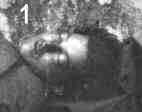
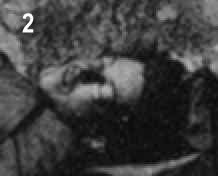
Photos 1 thru 6 details in order / purchased by the artist
from the Library of Congress. Photos 1 and 2 were taken at the UP hill
"Home" site. The other four photos were taken down the hill where the body
is currently thought to have been found.
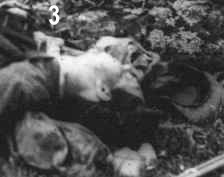
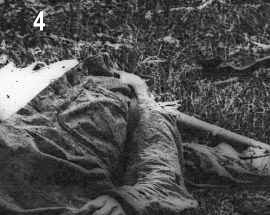
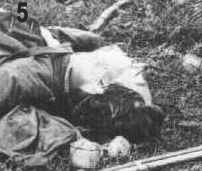
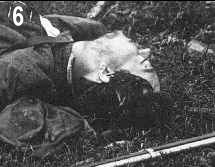
Let's consider something here. These photographers made their living
doing three quarter and frontal shots of people's faces all the time. The
body/dress is secondary. The face says it all! If
anything, Gardner, et al., seemed to be hiding the face in the 4 photos
taken down the hill. Why
would they want to hide the most recognizable and best feature of this
body? To my thinking, this is very odd.
Now take a look at both photos (1, 2) made of the body at the
"Sharpshooter's Home". Both
show the classic three-quarter facial shot-- which, by the way, is the view
most often chosen by
painters and photographers down through the ages. This is a very normal
approach for initially
capturing a subject. However, if we are told these photographs were taken
last and not first then
we should be confused as this goes against normal procedures.
Why would the photographers find a "great faced" subject down the hill
and spend a lengthy
interval taking four shots (two stereos and two wet-collodion plates)
showing everything BUT
the face.....then decide to move that body UP the hill 70 yards where they
then photograph the
face both times (once in plate, once in stereo)? This scenario makes no
sense. That is, it makes
no sense if the photos were made down the hill first.
Here is the much more obvious scenario. The only reason the
photographers would take pains
NOT to show the frontal or three-quarter view of the soldier's face in
their down-hill photos is
because such facial views are the most easily recognizable to the viewer.
Why would Gardner
and company not want the soldier to be recognizable to the viewer?
Probably because they had
already photographed the soldier at the up-hill site and did not want any
viewers to discover
they had moved the body to stage some additional photographs.
One might think that an upside down and rear-three-quarter head profile,
such as is shown in
three of the down-hill photographs, would be enough to discern the identity
of the soldier. But
history already has shown that this would be a false notion. Gardner had
the major audacity to
place a sample of each view of this confederate's body (one taken UP and
one taken DOWN)
back-to-back in his post-war book, "Photographic Sketchbook of the Civil
War" (plate 40, plate
41, herein photos 1 and 6). Not surprisingly, nobody noticed they were the
same body
photographed in two different places.
As mentioned before, the first person on written record to fathom the
similarities was the art-director working for "Civil War Times
Illustrated". And so, Gardner got away with his charade
for almost a hundred years. And I don't think for a moment he had
forgotten the whole episode
with the moving of the body. The truth is they are two of the finest
photographs
made on the battlefield. The corpse made a good subject even without
showing its facial
features. I believe the patch-pocket frock coat worn by the soldier added
something "soldier-esque" to the subject. None of the other Confederate
dead photographed on the battlefield were so well dressed. In fact, a
lengthy perusal (please take the time to see for yourself) will show they
were, with bare exception of three officers lying face down near the Rose
Woods area, dressed more like country folk. If you take away that
recurring prop rifle Gardner et al., kept using over and over, they appear
to be nothing more than common farm-hands. I feel certain that is one of
the reasons why the body of this particular sharpshooter was deemed
valuable for further photography in another location (there is a further
and very strong reason to move the body and I will mention it in depth
later on).
This was my initial observation concerning the matter of which photos
were made first. I
suppose I thought of this visual "face" cue because I am a visual artist-
like Gardner, O'Sullivan
and Gibson. In my own mind, I can sympathize and, to some extent, retrace
the photographers'
steps. Perhaps we think alike. Yet I shudder at some of the things
Gardner did then and later. I
suppose he was a master "paparazzi" of his time. He has done much to
confound history; yet
without his photographs we would have so much less.
After making this first simple observation about the face, I quickly
found other visual leads
which further strengthened the argument that the body was found up the hill
at the wall and
boulders. I was in no hurry to tell the world of my inclination. There
seemed to be no point in
dredging the whole thing up. It had nothing to do with my painting and I
resolved to let the
"sleeping dog lay". Plus it no doubt would arouse the ire of the
historians and some of my fellow
artists to boot. Still, I came back to the idea often; visual sleuthing is
a source of great amusement. Then came that day in May when I heard the
tour-guide say the soldier was a
"fake". In an electrical moment that word became the "F" word to my ears.
I had my resolve.
But if I was going to "go for it" then I knew I could not do so without
examining all original six
photos taken of this body. I had used book reproductions before and found
false or misleading
visual info. I could not absolutely depend on book photos for drawing my
own conclusions. A book photo is sometimes, through no intended fault of
its author, misleading. I knew the Library Of Congress had the originals
and now I would have to obtain my own copies.
Soon after visiting the LOC, I acquired 8x10 copies of all six photos
and stereos (three plates,
three stereos) for careful study. I began flushing out additional visual
clues that would indicate
the correct sequence of the six photographs. There are many. To help you
understand fully
what I found, I will continue by sub-headings in an attempt to stay
focused on each clue.